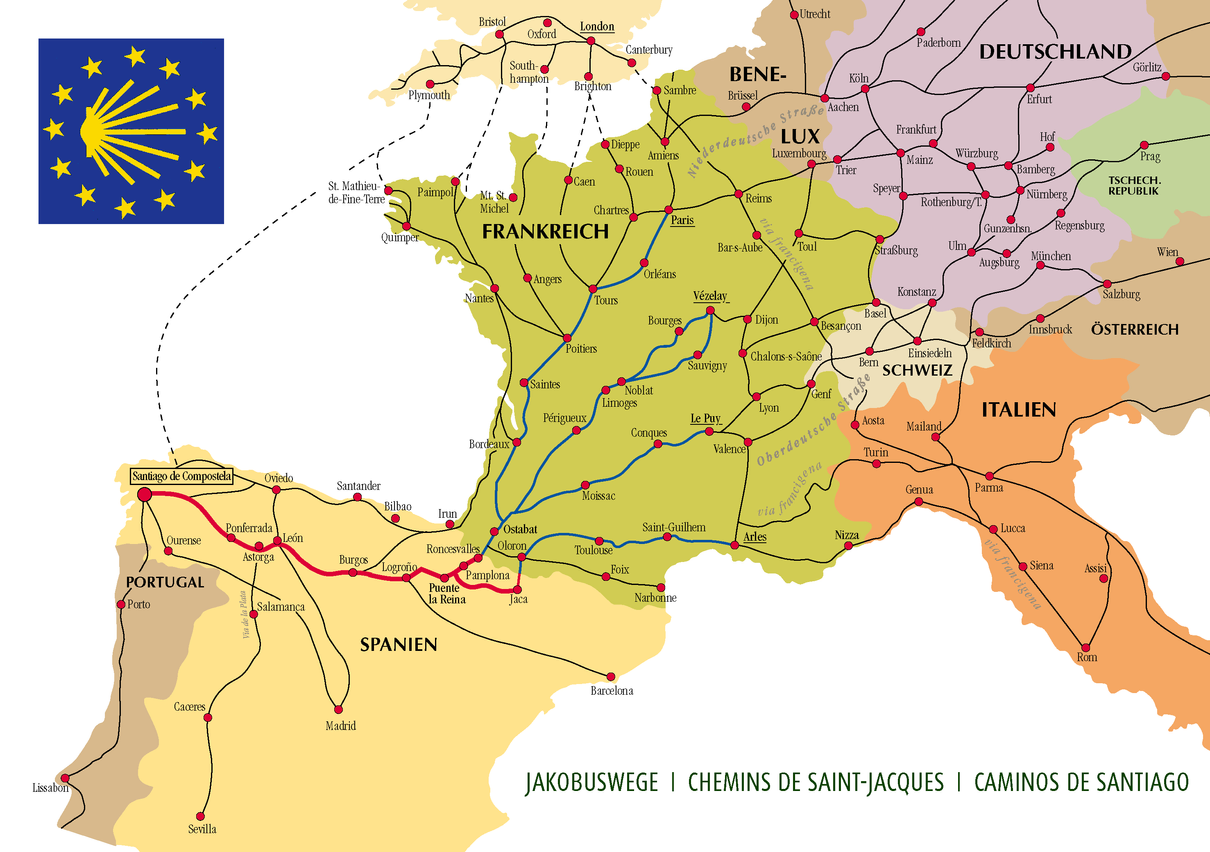Discovering the Camino de Santiago
- AMCL Schatz

- Jan 3, 2023
- 4 min read
Our first destination in Spain is Santiago de Compostela, the capital of Galicia in the country's northwest region. This city is known as the culmination of the Camino de Santiago (Way of Saint James).
The Camino de Santiago is the collective name for the numerous Christian pilgrimage routes leading to The Cathedral of Saint James, the shrine dedicated to the apostle, Saint James the Great. This is the place where the remains of the saint are said to be buried.
Since the Middle Ages, this pilgrimage, along with those to Rome and Jerusalem, has been considered one of the principal routes that earn the pilgrims a plenary indulgence (in the Catholic faith, this refers to “the remission before God of the temporal punishment due for sins already forgiven as far as their guilt is concerned”).
According to legend, Saint James’ remains were carried by boat from Jerusalem to northern Spain and buried on what is now the city of Santiago de Compostela. Since then, this pilgrimage has never ceased, though its popularity declined during the time of the Black Death plague, the Protestant Reformation, and several European wars. It has gained back its popularity in the late 70s and early 80s.
Traditionally, the pilgrimage route starts from the very doorstep of the pilgrim’s home but at present, there are several way-marked routes throughout Europe, all bearing the name Camino de Santiago and all converging at the shrine. There are twelve main routes, nine of which merge into the most popular one, the Camino Francés (The French Way), which runs from Saint-Jean-Pied-de-Port on the French side of the Pyrenees to Roncevalles on the Spanish side and through Pamplona, Logroño, Burgos, and Léon.
Other popular routes originate from France (Paris, Vézelay, Le Puy), or other parts of Spain (Somport Pass in Aragon and one from Madrid), or Portugal (Lisbon and Porto – one through the central region and one along the coast). Some are even from England or Ireland (by sea and disembarking in various ports in France). And there are routes from as far as Belgium, the Netherlands, Germany, Switzerland, Austria, Italy, and Poland.
We saw a lot of pilgrims making their way to Santiago – along the sidewalks, across the fields, and over the bridges. Some were resting under the shade of trees, some crisscrossing the pathways hidden behind village houses, and some taking a sip of water outside convenience stores. They had an almost-signature look – khaki pants or shorts, loose shirts, hiking boots, sun hats or bandannas, sunglasses, and heavy backpacks. Majority of them had the iconic pilgrim’s staff, a walking stick with a hook at the end on which hung a crosspiece or the scallop shell, the symbol of Camino de Santiago.
The scallop shell, often found on the shores of Galicia, has taken both a practical and a metaphorical meaning to the pilgrims. It was said that after Saint James’s death, his disciples shipped his body to the Iberian Peninsula to be buried in Santiago, but a heavy storm hit the ship off the coast of Spain and the body was lost to the ocean. After some time, it was found by a shepherd, washed ashore undamaged and covered in scallops. Another story states that Saint James’ body was transported by a ship piloted by an angel and when they docked, there was a wedding taking place along the shore. The groom was astride a horse and upon spotting the arriving ship, the horse got scared and plunged himself and the rider to the sea. But by a miracle, they emerged from the waters unscathed, covered in scallop shells.
On the more practical sense, the grooves of the scallop shells which meet at a single point remind one of the various pilgrim routes that have the same destination – Santiago. As well, the shell was the perfect size for gathering water to drink, or for use as a makeshift bowl for eating while on the road.
To be honest, I had never heard of the Camino de Santiago prior to this trip (in 2013). But learning about its history and grasping its meaning made me consider doing this pilgrimage at some point in this lifetime. Our Tour Director, who had done this four times from four different countries of origin, on four different seasons of the year, and on four varying lengths of time (from two months to more than a year), declared that doing this walk will change your life forever.
I had since read Paulo Coelho’s novel, "The Pilgrimage," and a couple of memoirs written by travelers whose journey through the camino have left a significant impact on their lives. I have also watched a short documentary on a DVD that I stumbled upon at a religious store. While checking online on this subject the other day, I was amazed at the amount of material available about camino travels – from the practical hiker’s guide types to spiritual reflections.
Photo Credits:
Manfred Zentgraf (Wikipedia), drifttravel.com, caminoways.com, world-today-news.com, caminoadventures.com, allposters.com, trafalgar.com




















Comments